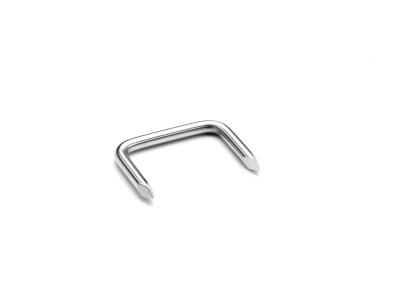E-mail iNfo@virkortho.shop Number +92-300-7477492

Epiphyseal Staple
Epiphyseal Staple is used for correcting angular deformity at the knee. Two or more Epiphyseal Staple should be used on each side of the epiphysis.
Our Epiphyseal Staples are made from finest quality medical grade material to ensure highest quality. Different sizes of Epiphyseal Staples are:
Dia(A) x Length(B) x Length(C) = 1.5 mm x 16 mm x 19 mm
Dia(A) x Length(B) x Length(C) = 1.5 mm x 22 mm x 19 mm
Dia(A) x Length(B) x Length(C) = 1.5 mm x 26 mm x 19 mm
Dia(A) x Length(B) x Length(C) = 2.0 mm x 16 mm x 19 mm
Dia(A) x Length(B) x Length(C) = 2.0 mm x 22 mm x 19 mm
Dia(A) x Length(B) x Length(C) = 2.0 mm x 26 mm x 19 mm
Dia(A) x Length(B) x Length(C) = 2.5 mm x 16 mm x 19 mm
Dia(A) x Length(B) x Length(C) = 2.5 mm x 22 mm x 19 mm
Dia(A) x Length(B) x Length(C) = 2.5 mm x 26 mm x 19 mm
Fifty six patients with angular deformities of eighty-two knees were treated with Epiphyseal Staple between 1954 and 1973 and followed until maturity. There were sixty-four knock-knees and eighteen bowlegs. In twelve patients with concurrent leg-length discrepancies, long legs were stapled asymmetrically. The deformities were allowed to overcorrect before the Epiphyseal Staple were removed, but the rebound phenomenon occurred in twenty-two patients with thirty-five deformities. In older children the Epiphyseal Staple were taken out when the legs looked straight. Exaggerated physiological deformities may correct spontaneously. They should not be stapled before the skeletal age of eleven in girls and twelve in boys. Secondary deformities are corrected earlier. There were no significant complications. Ten revisions of Epiphyseal Staples were necessary because of extrusion or shifting. The results were satisfactory or improved in 87 per cent of the deformities. When it is indicated epiphyseal stapling is a safe and effective method of correcting angular deformity at the knee in growing children.
Control of bone growth by epiphyseal staple
Efficient stapling of the distal femoral and proximal tibial epiphyses stops the elongation of bone at these epiphyses immediately and almost completely.
The operation is less extensive and the risk of complication is less than with other operative methods of controlling bone growth.
Angular deformity may be corrected during the growth period. Knock-knee, bowleg, back-knee, flexion deformity, or combinations of these deformities are rapidly overcome.
The occasional complicating irregularities of growth following stapling should be detected clinically and corrected immediately by rearrangement of the staples.
After removal of the epiphyseal staples, growth at the epiphysis is resumed at about the same rate as would be expected on the other side, if both sides were normal. It is sometimes faster and sometimes slower. The variations in rate are usually caused by factors other than epiphyseal staples.
The best proof of the normal rate of growth after removal of epiphyseal staples are the persistence of a straight extremity after correction of an idiopathic knock-knee.
About
Exceptional orthopedic instruments and implants from Pakistan.
Contact
Portfolio
© 2025 All rights reserved.
Location
Quick Link